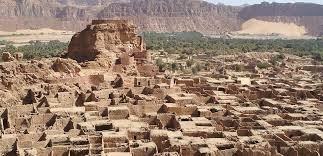Al-Ula Old Town: A Desert Ghost Town Frozen in Time
Nestled among the dramatic sandstone cliffs of northwest Saudi Arabia, Al-Ula Old Town stands as a silent witness to centuries of history. This labyrinthine settlement of mudbrick houses and narrow alleyways was abruptly abandoned in the 1980s, leaving behind a perfectly preserved time capsule of traditional Arabian life. Unlike ancient ruins weathered by millennia, Al-Ula Old Town’s buildings still stand intact, their wooden doors creaking in the wind as if waiting for residents who never returned. The village’s sudden desertion has spawned local legends of jinn (spirits) haunting its empty streets, with some Bedouins refusing to enter after sunset.
The Rise of a Desert Oasis Civilization of Al-Ula Old Town
Al-Ula Old Town’s story begins over 2,000 years ago as a crucial stop along the Incense Road, where caravans carrying frankincense and myrrh would rest between Petra and the Arabian Peninsula’s trading centers. What makes this settlement extraordinary is its continuous occupation through multiple civilizations – from the Dedanites and Lihyanites to the Nabataeans and Ottomans. The old town’s unique architecture reveals these layered histories, with some foundations incorporating stones from ancient Dedanite temples. During its 13th-century Islamic golden age, the town became famous for its skilled leatherworkers and date farmers who developed innovative irrigation systems still visible in the ruins today.
Secret Underground Passages and Hidden Rooms
Beneath the surface of Al-Ula Old Town lies one of its most fascinating mysteries – an extensive network of underground chambers and connecting tunnels. Recent archaeological surveys have revealed these hidden spaces were used for everything from food storage during sieges to secret meeting rooms during political unrest. The most intriguing discovery was a subterranean “courtroom” beneath what was once the mayor’s house, complete with carved stone seating. Local oral history tells of a secret tunnel stretching all the way to the nearby ancient city of Hegra (Madain Saleh), though this has yet to be verified by archaeologists.
The Great Abandonment of 1983
Unlike most historical sites that faded gradually, Al-Ula Old Town has a precise expiration date – 1983. That year, the Saudi government built modern housing with electricity and plumbing just 5 kilometers away, offering residents free relocation. Within months, the entire population of about 800 families moved out, leaving behind furniture, clothing, and even unfinished meals. The rush was so sudden that archaeologists later found school notebooks open on desks and pots still sitting on cooking fires. This abrupt departure created what experts call “a Pompeii of the modern era” – an entire community frozen at the moment of abandonment.

Architectural Marvels of a Bygone Era
Walking through Al-Ula Old Town is like stepping into an Arabian fairy tale. The settlement’s 900+ mudbrick buildings showcase ingenious desert architecture, including:
- Self-cooling houses designed with wind towers and strategic wall thickness to maintain comfortable temperatures
- Ancient security systems featuring maze-like alleyways and elevated walkways that allowed residents to escape raiders
- Unique door carvings where each family’s symbols told their tribal affiliation, occupation, and even number of children
- The “Whispering Walls” phenomenon – certain corners where sound carries perfectly between buildings, likely used as an ancient communication method
Forgotten Traditions of the Old Town Residents
Oral histories from former residents reveal fascinating aspects of daily life now lost to time. Every Thursday night, women would gather on rooftops to sing special folk songs called “Al-Mejmar” while grinding grain. The town had a unique barter system where dates were used as currency for small transactions. Most remarkably, Al-Ula maintained an ancient tradition of “moon farming” – planting and harvesting crops according to lunar cycles long after this practice disappeared elsewhere. Former residents still recall the haunting sound of the town crier’s drum echoing through the alleys each evening, signaling the closing of gates against desert predators.
Hollywood in the Desert: The Town’s Silver Screen Secrets
Few know that Al-Ula Old Town had a brief stint as a Hollywood backdrop before its abandonment. In the late 1970s, parts of the village were used to film scenes for “Antony and Cleopatra” (1972) and an Arabic production about the life of Prophet Muhammad. The production crews left behind fascinating artifacts – vintage film equipment was discovered in one building, while another still has Hollywood-style false facades nailed over original walls. These forgotten movie sets add another layer of mystery to the ghost town’s history.
Al-Ula Old Town: The Controversial Restoration Efforts
Today, Al-Ula Old Town stands at a crossroads between preservation and modernization. The Saudi government has begun careful restoration work, stabilizing crumbling walls and documenting original building techniques. However, some historians argue the project risks turning the authentic ghost town into a “living museum” attraction. The most heated debate centers around whether to leave the town in its abandoned state or repopulate it with artisans and shopkeepers to recreate traditional life. As Saudi Arabia opens to tourism through its Vision 2030 plan, Al-Ula Old Town may soon face its most dramatic transformation since its abandonment four decades ago.
Standing in the shadow of Al-Ula’s towering rock formations, the old town whispers stories of merchants, warriors, and families who called this place home. More than just an archaeological site, it serves as a poignant reminder of how quickly modern progress can render entire ways of life obsolete. For now, the morning sun still casts long shadows through its empty streets, illuminating fading Quranic verses painted on walls and the occasional child’s handprint preserved in dried mud – silent testimonies to the vibrant community that once thrived in this desert oasis.
Go to main page


